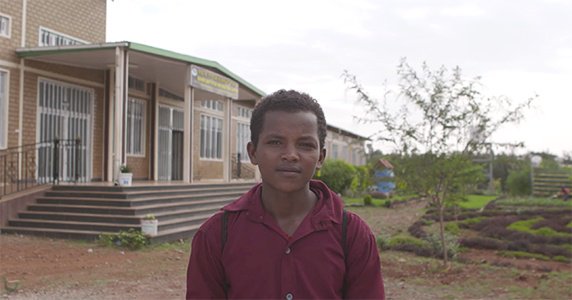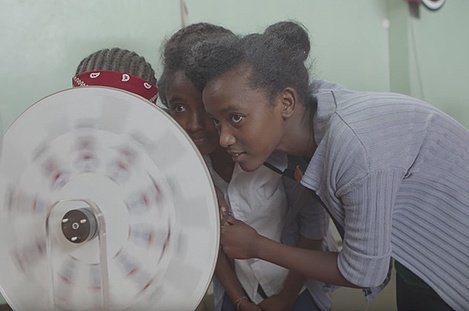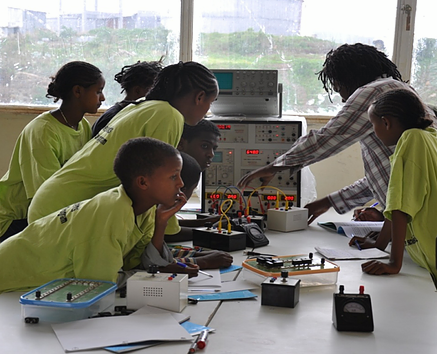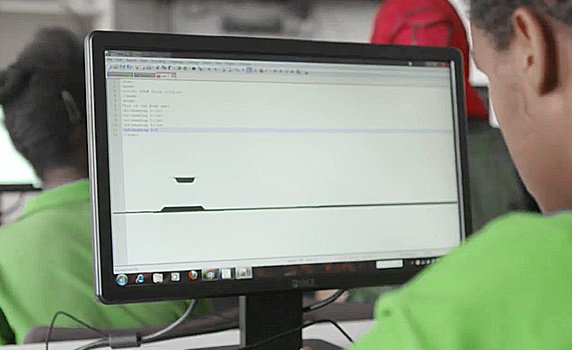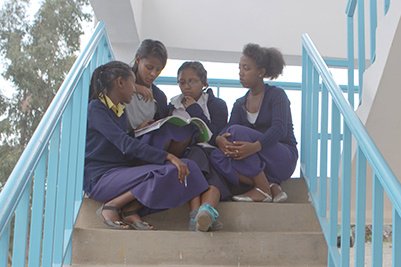STEM Centers & their Locations
Scaling pre-university STEM enrichment from community to national reach
Until recently, most students in East African schools had only books to study science&engineering, due to limited access to educational labs and real lab equipment. The Ethiopian government had a good plan to upgrade and expand the labs in their many universitiess, but STEM education in primary and secondary schools was barely considered.
The situation dramatically changed in 2009 when the GFCT Trust (the predecessor to STEM Synergy) constructed its first special-purpose STEM Center, near a primary school in Bishoftu city, in the industrial corridor of Ethiopia’s capital city Addis Ababa. No multi-discipline pre-university STEM Center had ever been established in Subsahara Africa, so we created a new practical extendable building design that would house labs, administration, equipment storage, and a large auditorium suitable for science fairs and community meetings.

Foka Science & Engineering Center, the first STEM Center in Ethiopia
The results were so spectacular that the Foka STEM Center sent shock waves through Ethiopia’s Ministry of Education. The government realized it now had a real replicable solution to offer hands-on STEM education to the nation. Moreover, each site would be individually expandable, to meet the needs of the local community as well as foster local innovation. Further, every STEM Center in this growing web could each host national forums and events.

During Foka’s initial electronics, computer and mechanical labs labs, 7th graders, December 2012
Each STEM Center performs mentoring using a combination of system-wide curricula and local specialties. System-wide curricula includes electronics engineering, mechanical engineering, and computer skills instruction.
STEM Synergy continues to establish more STEM Centers, always searching for local vendors, increased efficiency, and coordinated feedback.
To ensure sustainability and continuous impact , all STEM Centers are formally and legally handed over to their local associated university or community after two years of support and capacity building by STEM Synergy.
Locations of STEM centers built by STEM Synergy Ethiopia.
|
# |
Name of Center |
City, |
Project Status & Management |
Contact |
Website |
|
|
Mobile |
|
|||||
|
1 |
Foka Science and Engineering Center |
Beshoftu, Oromiya |
Implemented & transferred to Oromia Education Bureau |
(+251) |
[email protected] | |
|
2 |
Kallamino STEM Center |
Mekele, Tigray |
Implemented & transferred to Tigrai Education Bureau |
(+251) |
||
|
3 |
Gondar Univ Science Center |
Gondar, Amhara |
Implemented & transferred to Gondar Municipality |
(+251) |
||
|
4 |
Bahir Dar Univ STEM Incubation center |
Bahir Dar, Amhara |
Implemented & Transferred to Bahirdar University |
(+251) |
||
|
5 |
AASTU Univ STEM center |
Addis Ababa, chartered city |
Implemented & transferred to Addis Ababa Science & Technology University |
(+251) 913628761 |
||
|
6 |
Addis Ababa Science Museum |
Addis Ababa, Federal |
Implemented & transferred to Addis Ababa Science & Technology University |
(+251) |
||
|
7 |
ASTU Univ STEM center |
Adama, Oromiya |
Implemented & transferred to Adama Science & Technology University |
(+251) |
||
|
8 |
Hawassa University STEM center |
Hawassa, Southern (SNNPR) |
Implemented & transferred to Awassa University |
(+251) |
||
|
9 |
Jigjiga Mini-STEM Center |
Jigjiga, Ethiopian Somali State |
Implemented & transferred to Jijiga University |
(+251) 257755947 |
||
|
10 |
Asaita Univ Mini-STEM Center |
Asaita, |
Implemented & transferred to Afar Education Bureau |
(+251) |
www.facebook.com/Mohammed-Hanfere-School-STEM-Center-1723851311237296 |
|
|
11 |
Assosa Univ Mini-STEM Center |
Asossa, Beneshangul |
Implemented & transferred to Assosa Education Office |
(+251) 921816020 |
||
|
12 |
Wollega Univ STEM center |
Nekemet, Oromiya |
Implemented & transferred to Wellega University |
(+251) 930300124 (+251) 922224949 |
||
|
13 |
Kotebe Univ Science Shared Campus |
Addis Ababa |
Implemented & transferred to Kotebe Metropolitan University |
(+251) |
||
|
14 |
Liqa School Mini STEM Center |
Sodo, |
Implemented & transferred to Liqa boarding school |
(+251) |
||
|
15 |
Ethiopia Academy of Sciences |
Addis Ababa |
STEM Synergy still funding it |
(+251) 935987641 |
[email protected] Masresha Fetene |
eas-et.org/ |
|
16 |
Addis Ababa Institute of Technology |
Addis Ababa |
Implemented & transferred to Addis Ababa Institute of technology | (+251) 911233241 |
[email protected] | www.aait.edu.et/ |
|
17 |
Debremarkos STEM Center |
Debremarkos, Amhara |
STEM Synergy still funding it | (+251) 9290777 |
[email protected] Dr. Tafere Melaku (Univ president) |
http://www.dmu.edu.et |
| 18 |
Dilla U |
Dilla, Souhern (SNNPR) | STEM Synergy still funding it | (+251) 930507192 – or – 982003791 |
[email protected] Dr. Firehiwot Endal (R&T Xfer VP) |
http://portal.du.edu.et |
| 19 |
Haramaya U |
Dire Dawa chartered city | STEM Synergy still funding it | (+251) 912441024 |
Dr. Asfaw Kebede |
http://www.haramaya.edu.et |
| 20 |
Gode Polytch |
Gode, Ethiopian Somali |
STEM Synergy still funding it | (+251) 0915747716 |
[email protected] Mohamed Abdi (Dean) |
|
|
21 |
Kebridahar U STEM Center | Kebri Dahar, Ethiopian Somali |
STEM Synergy still funding it | (+251) 911268822 |
[email protected] Abdulfeta Ahmed (VP Admin) |
https://kdu.edu.et |
|
22 |
Harar STEM Center |
Harar. Harari |
STEM Synergy still funding it | (+251) 256661889 |
[email protected] Afendi Abdulwasi (Educ Bureau) |
|
| 22 |
Woldiya U STEM Center |
Woldiya, Semien Wollo |
STEM Synergy still funding it | (+251) 935990957 |
[email protected] Dr. Dawit Melese (VP Research) |
|
t
